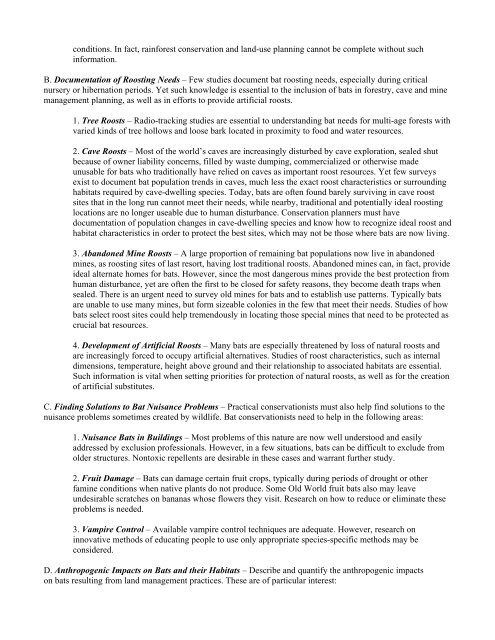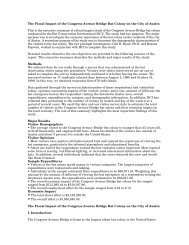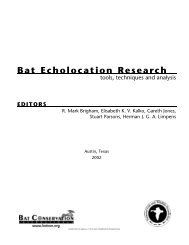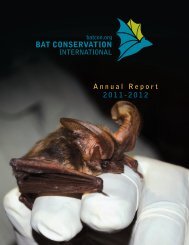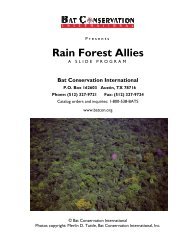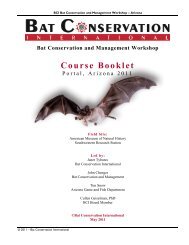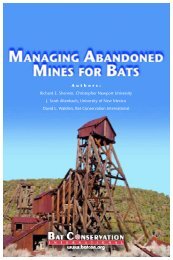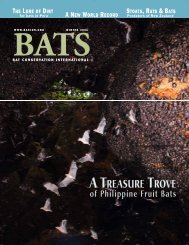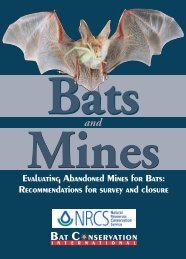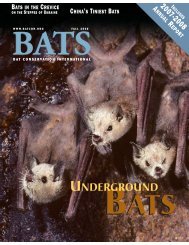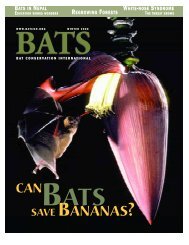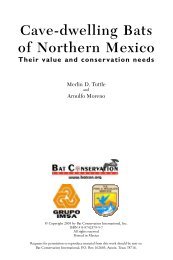Bat Conservation International
Bat Conservation International
Bat Conservation International
Create successful ePaper yourself
Turn your PDF publications into a flip-book with our unique Google optimized e-Paper software.
conditions. In fact, rainforest conservation and land-use planning cannot be complete without such<br />
information.<br />
B. Documentation of Roosting Needs – Few studies document bat roosting needs, especially during critical<br />
nursery or hibernation periods. Yet such knowledge is essential to the inclusion of bats in forestry, cave and mine<br />
management planning, as well as in efforts to provide artificial roosts.<br />
1. Tree Roosts – Radio-tracking studies are essential to understanding bat needs for multi-age forests with<br />
varied kinds of tree hollows and loose bark located in proximity to food and water resources.<br />
2. Cave Roosts – Most of the world’s caves are increasingly disturbed by cave exploration, sealed shut<br />
because of owner liability concerns, filled by waste dumping, commercialized or otherwise made<br />
unusable for bats who traditionally have relied on caves as important roost resources. Yet few surveys<br />
exist to document bat population trends in caves, much less the exact roost characteristics or surrounding<br />
habitats required by cave-dwelling species. Today, bats are often found barely surviving in cave roost<br />
sites that in the long run cannot meet their needs, while nearby, traditional and potentially ideal roosting<br />
locations are no longer useable due to human disturbance. <strong>Conservation</strong> planners must have<br />
documentation of population changes in cave-dwelling species and know how to recognize ideal roost and<br />
habitat characteristics in order to protect the best sites, which may not be those where bats are now living.<br />
3. Abandoned Mine Roosts – A large proportion of remaining bat populations now live in abandoned<br />
mines, as roosting sites of last resort, having lost traditional roosts. Abandoned mines can, in fact, provide<br />
ideal alternate homes for bats. However, since the most dangerous mines provide the best protection from<br />
human disturbance, yet are often the first to be closed for safety reasons, they become death traps when<br />
sealed. There is an urgent need to survey old mines for bats and to establish use patterns. Typically bats<br />
are unable to use many mines, but form sizeable colonies in the few that meet their needs. Studies of how<br />
bats select roost sites could help tremendously in locating those special mines that need to be protected as<br />
crucial bat resources.<br />
4. Development of Artificial Roosts – Many bats are especially threatened by loss of natural roosts and<br />
are increasingly forced to occupy artificial alternatives. Studies of roost characteristics, such as internal<br />
dimensions, temperature, height above ground and their relationship to associated habitats are essential.<br />
Such information is vital when setting priorities for protection of natural roosts, as well as for the creation<br />
of artificial substitutes.<br />
C. Finding Solutions to <strong>Bat</strong> Nuisance Problems – Practical conservationists must also help find solutions to the<br />
nuisance problems sometimes created by wildlife. <strong>Bat</strong> conservationists need to help in the following areas:<br />
1. Nuisance <strong>Bat</strong>s in Buildings – Most problems of this nature are now well understood and easily<br />
addressed by exclusion professionals. However, in a few situations, bats can be difficult to exclude from<br />
older structures. Nontoxic repellents are desirable in these cases and warrant further study.<br />
2. Fruit Damage – <strong>Bat</strong>s can damage certain fruit crops, typically during periods of drought or other<br />
famine conditions when native plants do not produce. Some Old World fruit bats also may leave<br />
undesirable scratches on bananas whose flowers they visit. Research on how to reduce or eliminate these<br />
problems is needed.<br />
3. Vampire Control – Available vampire control techniques are adequate. However, research on<br />
innovative methods of educating people to use only appropriate species-specific methods may be<br />
considered.<br />
D. Anthropogenic Impacts on <strong>Bat</strong>s and their Habitats – Describe and quantify the anthropogenic impacts<br />
on bats resulting from land management practices. These are of particular interest:


